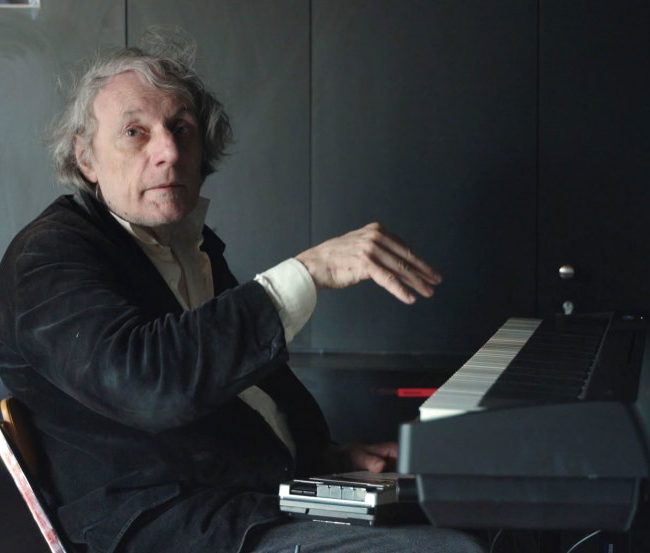(The Edge of Dreaming is now available on DVD through Lorber Films. Go here to learn more.)
At the beginning of The Edge of Dreaming, filmmaker Amy Hardie, a woman who admittedly never remembers her dreams, has an uncanny one. In this dream, her old horse, George, whom she is riding, wants to know if she’s filming; he tells her to “get ready to film.” Then he tells her that he’s going to die and starts to fall.
Hardie wakes up and goes outside with her camera. She finds George lying on the ground on his left side (“I will fall to the left” he has told her in her dream), dead of a heart attack. Deeply shaken and disturbed by this seemingly premonitory sign from her subconscious mind, she documents George’s burial. In fact, this filmmaker, who makes science films for a living, starts to document everything—her loving husband, her happy, playful children (one son and two daughters), the dog, the cat, the house, the land, every aspect of her extremely contented life in the Scottish countryside. As a maker of science films, Hardie is a regular investigator of “real” phenomena, interested in finding out how things “really work,” basing her stories around scientific proofs, rigorous research, quantifiable outcomes and conclusions.
Soon after having dreamed about George’s death as it was happening, Hardie has another dream, one that will turn her life, and all she understands about it, upside down. Her former partner, Arthur, is the father of her son; they separated as a couple long ago, but remained close. Four years earlier, when their son was 14 years old, Arthur died of cancer. In the dream, he speaks to her in Spanish (he’s from Gibraltar, a British territory on the southern end of the Iberian peninsula), saying, “. . . I think it is better that you know. You are going to die when you are 48. It’s not up to me. I heard it and thought you would want to know. When you reach 48, that will be your last year of life. I’m sorry.” Hardie is about to turn 48. Slightly panicked, she wonders—is this the last year of her life?
By documenting and telling the story of her thoughts, feelings, fears and superstitions throughout this period of intense trauma (things escalate when she falls ill with a lung malady in the spring), Hardie, good scientific researcher that she is, delves into a deep investigation about the liminal territory between our waking and dreaming states. That she does this in such a thoroughly engaging, deeply personal way is this film’s strongest aspect.
 Hardie constantly acknowledges the intense “selfishness” that comes with any kind of death sentence, be it imagined or real. The intense fear she lives with every day is compared to a mushroom, “something that grows and grows on its own in the dark.” Is Arthur’s voice as prophetic as George’s was? She shares the Arthur dream with her son, who is now 18. Even though he engages in this discussion in a somewhat dispassionate way, she soon realizes she probably should not have told him about it, knowing that he’s already had to experience the loss of one parent at a young age. Wisely, she chooses not to say anything to her two young daughters. But in her daily filming, she has casual, yet probing, conversations with all of her children about death, asking them what they think happens to us when we die.
Hardie constantly acknowledges the intense “selfishness” that comes with any kind of death sentence, be it imagined or real. The intense fear she lives with every day is compared to a mushroom, “something that grows and grows on its own in the dark.” Is Arthur’s voice as prophetic as George’s was? She shares the Arthur dream with her son, who is now 18. Even though he engages in this discussion in a somewhat dispassionate way, she soon realizes she probably should not have told him about it, knowing that he’s already had to experience the loss of one parent at a young age. Wisely, she chooses not to say anything to her two young daughters. But in her daily filming, she has casual, yet probing, conversations with all of her children about death, asking them what they think happens to us when we die.
Her husband, a serene and open-minded psychotherapist, listens generously to her thoughts and feelings and assuages her fears and anxieties as best he can. But when she does fall seriously ill, even his composure starts to slip a bit and he admits that he, too, is frightened. Are they really supposed to live as if she is dying—based on a dream that she had?
The Edge of Dreaming is a quiet film, almost a peaceful one, considering the emotional and psychic trauma it illustrates so beautifully. There is scene after scene filled with contemplative moments, even though Hardie fights daily against being consumed by her growing fear that her life will soon be over. She means to get to the bottom of this because she does not want to die. Yet, she is determined, no matter what, to make a record of life just in case this is to be the only legacy left to her growing children. As she continues to search for answers, she meets with various dream researchers and theoreticians, wanting someone—anyone—to rationally explain what has happened to her and why she dreamed about her own death.
Twenty days before her 49th birthday, not having found any satisfactory answers to her quest for a logical and scientific explanation for her dream, Hardie goes to see a shaman, intent on, somehow, “changing” her dream by being guided back into the dream state while awake. Whatever your personal beliefs about this subject matter, the recreated visual manifestations of her shamanic-led journey, animated from her descriptions about what she’s “seeing” during this visualization, are deeply emotional, and feel very, very real—in some ways, more real than the glorious beauty of the nature she films all around her, more real than the laughter and clowning around with her kids and pets we see on her home videos.
This personal film is told with a keen intelligence, even in the midst of Hardie’s darkest times of despair. By investigating the one thing that most of us are deeply afraid of, this filmmaker has created an ode to all of our senses, not just those limited to our waking perceptions. The Edge of Dreaming provides no facile or conclusive answers at all, instead illustrating what is most mysterious and magical about the undying love we have for life.
The overall production is artfully enhanced by Gunnar Óskarsson’s superb sound design, Jim Sutherland’s subtle and moving musical composition, graceful editing by Ling Lee, and breathtaking cinematography by Hardie.
— Pamela Cohn












Pingback: PBS and filmmaker Amy Hardie: The Edge of Dreaming
Stephen Parker
In spite of some minor flaws, this is timely and worthwhile film to see
For me, the documentary was frequently too self-focused, too much time spent on Ms. Hardie’s personal angst and not enough time on the nature of dreaming. I almost turned the TV off after the long opening about Ms. Hardie dream and sequence about her dead horse; I am glad that I didn’t.
Ms. Hardie chose to go to a shamanic healer to deal with the premonitory power of the dream that she was going to die. (In an interview with Ms. Hardie, she said that she went to three different psychotherapists first… I would still suggest that an experienced depth psychologist who works with trance and dreams might also have been as effective as the shaman.)
Nevertheless, as a result of the competence and the setting created by the shamanic healer and Ms. Hardie’s belief in the power of the shaman, Ms. Hardie clearly went into a profound altered state of consciousness that altered her pysche and,consequently and profoundly, altered her physical body. (During an interview, Ms. Hardie said that she was absolutely sure that she had been healed after the shamanic intervention.)
Interestingly, Ms. Hardie’s experience was a parallel journey to an ancient healing ritual that lasted over a thousand years, of visiting the temples of Aesclepius in Greece in order to have a healing dream. One had to journey far to get to these places, and the dream pilgrim was almost always in the midst of a crisis of mortality. Snakes were often strongly featured in these Aesclepian healing dreams. [They are a symbol of re-birth (from the shedding of their skin) and a symbol of ancient, deep animal instinct.] This particular sequence of the visions during the shamanic healing was quite well done.
I would hope that this film itself is a premonition of an increased in the power of dreams and healing in this dream-aversive and overly-rational culture. We have already had the film “Inception” this year; this is an excellent sequel.
Pingback: HOME VIDEO PICKS – Hammer to Nail